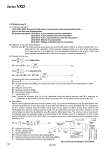
7-p0101-0151-newvxd_en 45 / 55
10秒後にBOOKのページに移動します
Series VXD Fig. (2) Test circuit based on JIS B 8390 Pressure switch Power supply Solenoid valve Equipment for test Rectifier tube on the downstream side Rectifier tube on the upstream side Pressure gauge or pressure convertor Timer (Clock) Pressure recorder Control circuit Thermometer Air tank Pressure control equipment Shut off valve Air Filter supply 2.2 Effective area S (1) Conformed standard JIS B 8390: 2000: Pneumatic fluid power.Components using compressible fluids. How to test flow-rate characteristics Equipment standards: JIS B 8373: 2 port solenoid valve for pneumatics JIS B 8374: 3 port solenoid valve for pneumatics JIS B 8375: 4 port, 5 port solenoid valve for pneumatics JIS B 8379: Silencer for pneumatics JIS B 8381: Fittings of flexible joint for pneumatics (2) Definition of flow-rate characteristics Effective area S: The cross-sectional area having an ideal throttle without friction or without reduced flow. It is deduced from the calculation of the pressure changes inside an air tank when discharging the compressed air in a choked flow, from an equipment attached to the air tank. This is the same concept representing the “easy to run through” as sonic conductance C. (3) Formula for flow rate When . 0.5, choked flow Q = 120 x S (P1 + 0.1) ...............................................................(3) When > 0.5, subsonic flow Q = 240 x S (P2 + 0.1) (P1 - P2) ............................................(4) Conversion with sonic conductance C: S = 5.0 x C ....................................................................................................(5) Q : Air flow rate [dm3/min(ANR)], dm3 (cubic decimeter) of SI unit are allowed to be described by L (liter). 1 dm3 = 1 L S : Effective area [mm2] P1 : Upstream pressure [MPa] P2 : Downstream pressure [MPa] t : Temperature [°C] Note) Formula for subsonic flow (4) is only applicable when the critical pressure ratio b is unknown for equipment. In the formula (2) by the sonic conductance C, it is the same formula as when b = 0.5. (4) Test method Attach a test equipment with the test circuit shown in Fig. (2) in order to discharge air into the atmosphere until the pressure inside the air tank goes down to 0.25 MPa (0.2 MPa) from an air tank filled with the compressed air at a certain pressure level (0.5 MPa) which does not go below 0.6 MPa. At this time, measure the discharging time and the residual pressure inside the air tank which had been left until it turned to be the normal values to determine the effective area S, using the following formula. The volume of an air tank should be selected within the specified range by corresponding to the effective area of an equipment for test. In the case of JIS B 8373, 8374, 8375, 8379, 8381, the pressure values are in parentheses and the coefficient of the formula is 12.9. S = 12.1 log10 ( ) .............. (6) S : Effective area [mm2] V : Air tank capacity [dm3] t : Discharging time [s] Ps : Pressure inside air tank before discharging [MPa] P : Residual pressure inside air tank after discharging [MPa] T : Temperature inside air tank before discharging [K] 273 + t 293 273 + t 293 P1 + 0.1 P2 + 0.1 P1 + 0.1 P2 + 0.1 P + 0.1 PS + 0.1 t V T 293 142